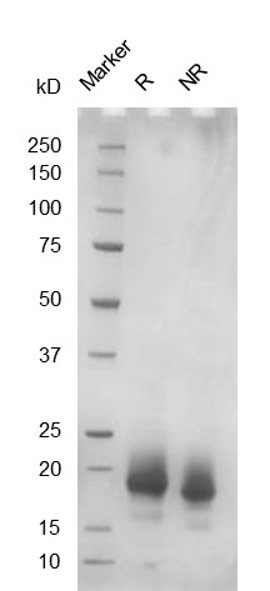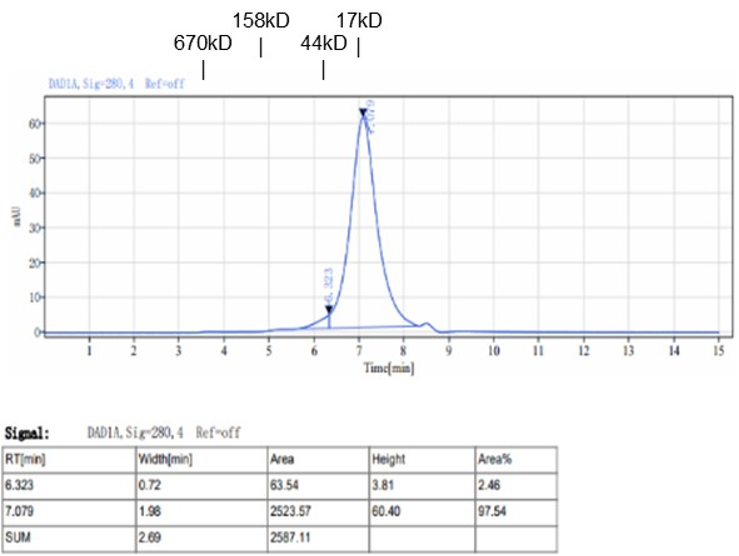hIL4(25-153)-His
Description
Interleukin-4 (IL4) is a cytokine primarily secreted by mast cells, T-cells, eosinophils and basophils. It plays a role in regulating antibody production, hematopoiesis, inflammation, and the development of effector T-cell responses. IL4 promotes the proliferation and survival of B-cells and T-cells, as well as immunoglobulin class switch to IgG1 and IgE isotypes. It also facilitates acquisition of the Th2 phenotype by naive CD4+ T cells, priming and chemotaxis of mast cells, eosinophils and basophils, and the proliferation and activation of epithelial cells. Additionally, IL4 regulates the expression of the low affinity Fc receptor for IgE (CD23) on lymphocytes and monocytes. It positively modulates IL31RA expression in macrophages. Moreover, IL4 significantly contriubutes to higher functions of the normal brain, such as memory and learning. It exerts a dominant influence on allergic inflammation development and asthma pathogenesis. Upon binding to IL4, IL4R receptor dimerizes either with the common IL2RG to produce Type 1 signaling complex, located mainly on hematopoietic cells, or with IL13RA1 to produce Type 2 complex, which is expressed also on nonhematopoietic cells. Engagement of both types of receptors initiates JAK3 and to a lower extend JAK1 phosphorylation, leading to activation of STAT6 signaling pathway. Due to its involvement in the differentiation of certain immune cell types, IL4 is frequently employed in combination with other growth factors to transform induced pluripotent stem cells into dendritic cells in high numbers. These dendritic cells can then be used for research or clinical applications to improve disease modeling, for screening and cell therapies. Studies focusing on IL4 signaling have paved the way for monoclonal antibodies development that can block the signaling pathway at various steps to mitigate the inflammatory response in certain autoimmune diseases. Blockade of IL4 signaling has also been explored as a therapeutic target to suppress inflammation in the tumor microenvironment.
Product name | hIL4(25-153)-His |
Species | Homo sapiens |
Expression system | HEK293 |
Buffer | PBS, pH 7.4 |
Delivery condition | Dry ice (-80°C) |
Delivery Time | 1 week if in stock; 4 weeks if production needed |
Storage condition | Store at -80°C |
Brand | BioMetas |
Applications | Allergy Research, Apoptosis Research, Cancer Research, Cell Culture, Immune Checkpoint, Immune System, Immunotherapy, Inflammation Research, Organoids, Stem Cells & Differentiation, Targeted Therapy, Transplantation Research |
Aliases/Synonyms | IL-4, IL4E12, B cell growth factor 1, BCGF-1, BCGF1, BCGF, B-cell stimulatory factor 1, BSF-1, BSF1, binetrakin, lymphocyte stimulatory factor 1, pitrakinra, MGC79402, BCDF |
Reference | |
Note | For research use only. Not suitable for clinical or therapeutic use. |
Size | 1mg, 5mg, 10mg, 50mg, 100mg |
Brand | BioMetas |
Product type | Cytokine |
Expression system | HEK293 |
Applications | Allergy Research, Apoptosis Research, Cancer Research, Cell Culture, Immune Checkpoint, Immune System, Immunotherapy, Inflammation Research, Organoids, Stem Cells & Differentiation, Targeted Therapy, Transplantation Research |
Contact Us for a Quote!
Data Gallery
Fig. 1.) 4-20% SDS-PAGE analysis
Recombinant protein was visualized by Coomassie Brilliant Blue R250 staining.

Fig. 2.) SEC-HPLC analysis
Column: Superdex 200 Increase 5/150 GL
Running buffer: 2xPBS, pH 7.4
